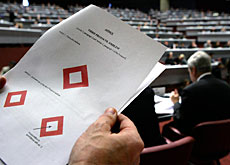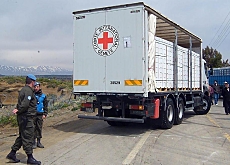Red Cross opened to Israel

The Red Cross humanitarian movement has extended membership to Israel and Palestinian relief agencies at a meeting in Geneva.
The agreement – reached in the early hours of Thursday – paves the way for a new red crystal symbol and puts an end to Israel’s nearly 60-year struggle for accession.
Switzerland, the depositary state of the Geneva Conventions, has pushed for the adoption of a third neutral humanitarian emblem.
The Geneva Convention’s 192 signatory states and 183 national Red Cross and Red Crescent societies decided in a rare vote to approve a new red crystal emblem for use where the cross and crescent are uncomfortably linked with Christianity and Islam.
The diamond-shaped symbol, into which the Star of David may be placed, made it possible for Israel’s Magen David Adom (MDA) to join the humanitarian network – which makes up the world’s largest relief agency – after decades of isolation.
Two politically charged days of talks spilled into the early hours of Thursday, when delegates agreed to admit both the MDA and the Palestine Red Crescent Society in what conference chairman Mohammed Al Hadid called “a historical moment”.
The move should help engender better cooperation between Israeli and Palestinian relief services, and ensure more universal access to those needing help from the international relief network, Al Hadid told reporters after the decision.
Dues withheld
“This is an extraordinarily exciting evening,” said Bonnie McElveen Hunter who chairs the board of the American Red Cross, which had been campaigning for year for the Israeli society’s admission.
She added her organisation would repay about $45 million (SFr 55.5 million) in dues withheld from the International Federation of Red Cross and Red Crescent Societies over concerns about MDA’s exclusion.
Israel’s ambassador to the meeting, Itzhak Levanon, said the International Conference of the Red Cross and Red Crescent had earlier thrown out a Muslim amendment that would have challenged Israel’s occupation of Arab territory since 1967.
Despite time-consuming legal and procedural complaints from representatives of the Organisation of the Islamic Conference, and a proposed amendment from Pakistan and Tunisia seeking to add wording unacceptable to Israel, the resolution passed with more than the required two-thirds majority support.
Some 237 states and societies voted to change the agency’s statutes and add the red crystal symbol, 54 voted against, and 18 abstained, officials said.
Applause greeted the result of the vote to admit the Israeli and Palestinian groups to the network.
Al Hadid said that all national societies could use the red crystal logo in places where the neutral symbol could improve access to victims or reduce risks against aid workers.
“The emblem will not only be used in Israel,” he said.
swissinfo with agencies
The red cross emblem, which was officially approved in 1864, is based on the Swiss flag with the colours reversed.
The red crescent was adopted during the war between Russia and the Ottoman Empire (1876-1878). It is based on the Turkish flag, with the colours switched.
Some countries, such as Israel, have found it difficult to use either of the emblems. Hence the move to adopt an additional symbol that is free of any national, cultural, religious, political or ethnic connotations.

In compliance with the JTI standards
More: SWI swissinfo.ch certified by the Journalism Trust Initiative


You can find an overview of ongoing debates with our journalists here. Please join us!
If you want to start a conversation about a topic raised in this article or want to report factual errors, email us at english@swissinfo.ch.